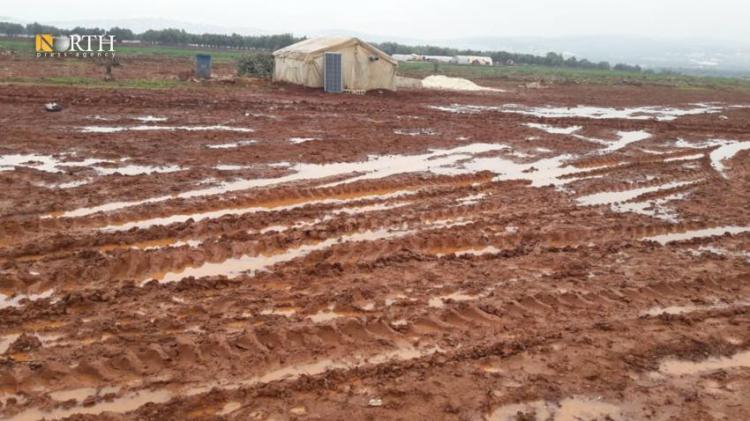IDP camp in Idlib flood with heavy rains
Idlib – North-Press Agency
Heavy rains which northwestern Syria have been exposed to several days ago, have increased the suffering of the northern Syria IDPs, while hundreds of families are still without shelters or, as a result of the recent military operation on Idlib’s southern and southeastern axes.
Dozens of camps have sunk
Media activist Teim al-Ghabi, told North-Press that the rainstorm that has been going on for weeks on northern Syrian camps, especially the ones near the Syrian-Turkish border, that caused dozens of camps to drown, in addition to causing dirt and swamps inside the camps, which made living extremely difficult. As al-Ghabi pointed out that the road between these tents needs paving, especially as they are unqualified roads, in addition to organizing water leaks, isolating the floor for tents, and establishing rain drains, sanitation and toilets, "perhaps it will alleviate a little the suffering of the families who have recently been displaced," he said.
Interruption of basic needs
While al-Taleea camp, near the town of Bennish, east of Idlib, the heavy rains that fell on the camp have caused the sinking of 11 tents, in addition to the interruption of all roads leading to the camp due to accumulated mud, neither the residents are able to leave the camp to the neighboring villages to buy basic household needs such as bread and others, nor do the cars in case of an emergency.
According to the camp's manager, it includes about 200 displaced families, most of whom are from Hama eastern countryside, including dozens of families who were in the camps of Maarat al-Numan and its eastern countryside, where the camp needs many basic services, especially water and bread.
Great damage
during his talk to North-Press, the director of Syria Response Coordinator Team Muhammad Hallaj, estimated the number of newly arrived IDPs from Hama and Idlib countryside, between early November to late December is about 283,465 thousand people.
The displaced people were distributed in several areas in the Syrian north, the most prominent of which are the city of Idlib, the camps of Harem and Armanaz, and the camps of Atma and Kafr lousin on the Syrian-Turkish border, in addition to thousands of them who left to Afrin, Azaz, Jarablus and al-Bab in Aleppo northern countryside.
Resort to the mountains
Journalist Abdulrahman al-Idlabi, for his part, said that most of the camps are built on agricultural land, and most of them were established in the summer, but the organizations responsible for them were not alert to torrential rain, and that the camps would be turning into muddy grounds that prevent the movement of people.
As for the newly displaced people, some of them went to the mountains and highlands to avoid the sinking of their tents, but this reduced the bad impact of rain, not the freezing cold air.
The Syrian government and Russian forces have escalated their bombardments on the villages and towns of Idlib and Hama countryside since the beginning of December 2019, causing the displacement of about half a million civilians, most of them are from Maarat al-Numan, according to the Syrian Response Coordinators Team.

